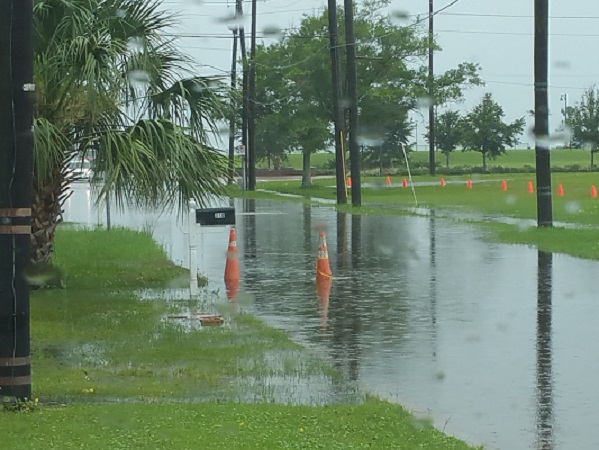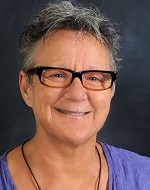Apply now to join our next cohort of Community Science Fellows and Community Leads!

Photo Courtesy of Gloria Horning
Project Results for Pensacola, FL
The Team
Gloria Horning, Tanyard Association
Jaap Nienhuis, Utrecht University
Results
The focus of this project was to better understand how and why the Tanyard area of Pensacola continually floods. The initial objective was to investigate the urban flooding, synthesize available reports, develop next steps and proposed solutions to deal with the flooding, and design an educational campaign aimed at community members and local decision makers.
A synthesis/problem summary was completed that characterizes the existing flooding infrastructure and outlines potential solutions for the community including the installation of pumps, the expansion of retention ponds that can drain to bay under sufficient grade (potentially during low tide) and/or the elimination of illicit connections to prevent storm water inflow into the sanitary sewer.
Project Outputs:
Project Impacts:
Reflections
From this project, others may learn better ways to partner with Thriving Earth Exchange for their own purposes. For instance,
To other teams currently pursuing Thriving Earth Exchange projects and for those that anticipate doing a Thriving Earth Exchange project, the team recommends:
The Tanyard is one of Pensacola’s oldest neighborhoods, sitting just west of downtown. Centered around Pensacola’s working waterfront, the neighborhood was once a diverse community with a burgeoning industry, creole cottages and shotgun homes. Washerwoman Creek, a freshwater spring named by the British who occupied the area in the mid-late 1780s and reflective of the tanneries dotting the area at the time, was eventually filled and covered by development with government buildings. Today, during heavy rain events, the water that once drained to the creek floods into the predominantly African American neighborhood. Outdated infrastructure means that raw sewage is often seen running down the streets, creating a health hazard for residents. Elevated levels of Enterococcus Bacteria have been found at a local beach. In 2004 Hurricane Ivan struck Pensacola particularly hard, initiating a federally declared disaster; flood survivors in The Tanyard express fears over the next big storm. High tide events, combined with heavy rainfall and storm surge overwhelm storm drains, flooding homes and businesses. Stormwater often takes weeks to drain from the streets.
Pensacola and Escambia County have a long history of environmental contamination. The EPA currently lists 5 Superfund sites within the city limits of Pensacola including an old wood treatment facility, landfill, and an active naval station. During their operations, these sites generated wastes that contaminated soil, sediments, ground and surface waters. In June of 2016 contaminated groundwater containing lindane-an agricultural insecticide also used as a pharmaceutical treatment for lice and scabies-was found at Corinne Jones Park in The Tanyard.
The Tanyard Association was formed in 2005 to address concerns related to the rapid gentrification of the neighborhood, industrial development, ongoing contamination, and flooding. The group’s Facebook page has over 70 followers. In the face of rapid gentrification, the group is rallying to address the chronic flooding in a way that preserves their cultural heritage and identity. The Tanyard Association would like to obtain a better understanding of the causes of flooding in their neighborhood. The group would like to work with a dedicated hydrologist to investigate local hydrodynamics, synthesize available reports and develop next steps or proposed solutions. The Tanyard Association will use their enhanced understanding to have productive interactions with local decision-makers.
This project has been conceived and designed in partnership with community leaders at The Tanyard Association and Flood Forum USA.
Community Leads

Gloria G. Horning, Ph.D. is a social and environmental justice advocate based in Pensacola, Florida. She has nearly thirty-years experience in working with disenfranchised communities that continue to be plague by unregulated landfills in the historic African-American communities–Wedgewood, Rolling Hills and Olive Heights. Currently Dr. Horning is fighting for flood relief in the oldest neighborhood in Pensacola — The Tanyard. Dr. Horning holds a Ph.D. from Florida State University. Her dissertation focused on environmental issues facing small communities’ and the health impacts on the citizens.
Dr. Horning is the Vice President of the Tanyard Association and will serve as the community lead. Dr. Horning will be supported by Marilynn Lowe, President of the Tanyard Association.
Scientific Liaison

Jaap Nienhuis is an assistant professor at Florida State University, where he leads the Coastal Morphodynamics group. His work primarily involves developing and applying hydrodynamic and morphodynamic models of coastal environments to better understand and predict coastal change and coastal hazards such as flooding and erosion. Jaap Nienhuis obtained BS and MS degrees in coastal engineering in the Netherlands, and a PhD from MIT-WHOI specializing in coastal sediment transport. Prior to joining FSU, Jaap Nienhuis worked in New Orleans studying subsidence and wetland restoration of the Louisiana coastal environment.
This project is part of one of Thriving Earth Exchange’s cohorts. Thriving Earth Exchange has partnered with Flood Forum USA which supports grassroots flood groups across the country by helping them develop strategies for a sustainable future. Thriving Earth Exchange is working with 15 of their grassroots groups to connect them with scientists who can help them better characterize neighborhood-level flood risks and work effectively with local decision makers to mitigate those risks.

ISeeChange is dedicated to empowering communities to document and understand their environment, weather and climate in order to increase resilience. ISeeChange mobilizes communities to share stories and micro-data about climate impacts to inform and improve climate adaptation and infrastructure design. Their platform, tools, and investigations provide equitable, iterative ways for residents to personalize, measure, and track climate change impacts and better participate in community adaptation decisions.
Each post is synced with weather and climate data and broadcast to the community to investigate bigger picture climate trends. Over time, community members can track how climate is changing, season to season, year to year, and understand the impacts on daily life.
ISeeChange is a strategic partner of Thriving Earth Exchange as community members use their platform and tools to better characterize, visualize, and communicate neighborhood-level climate trends and co-develop solutions to mitigate those risks.

(c) 2024 Thriving Earth Exchange